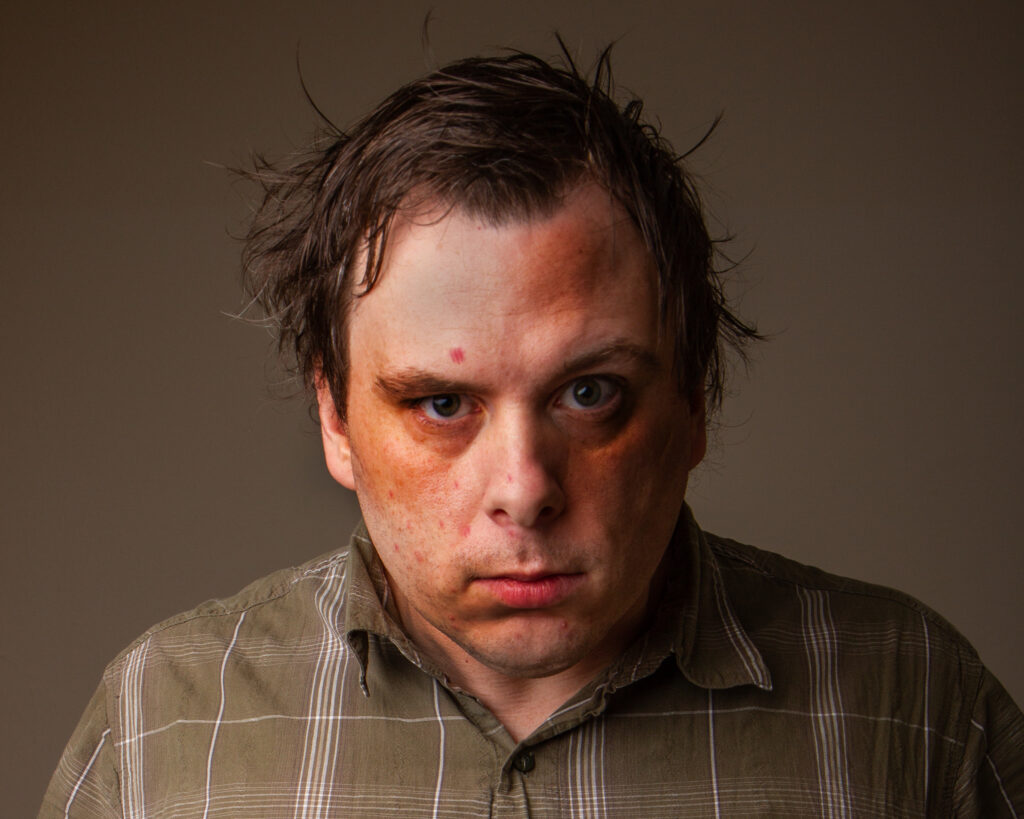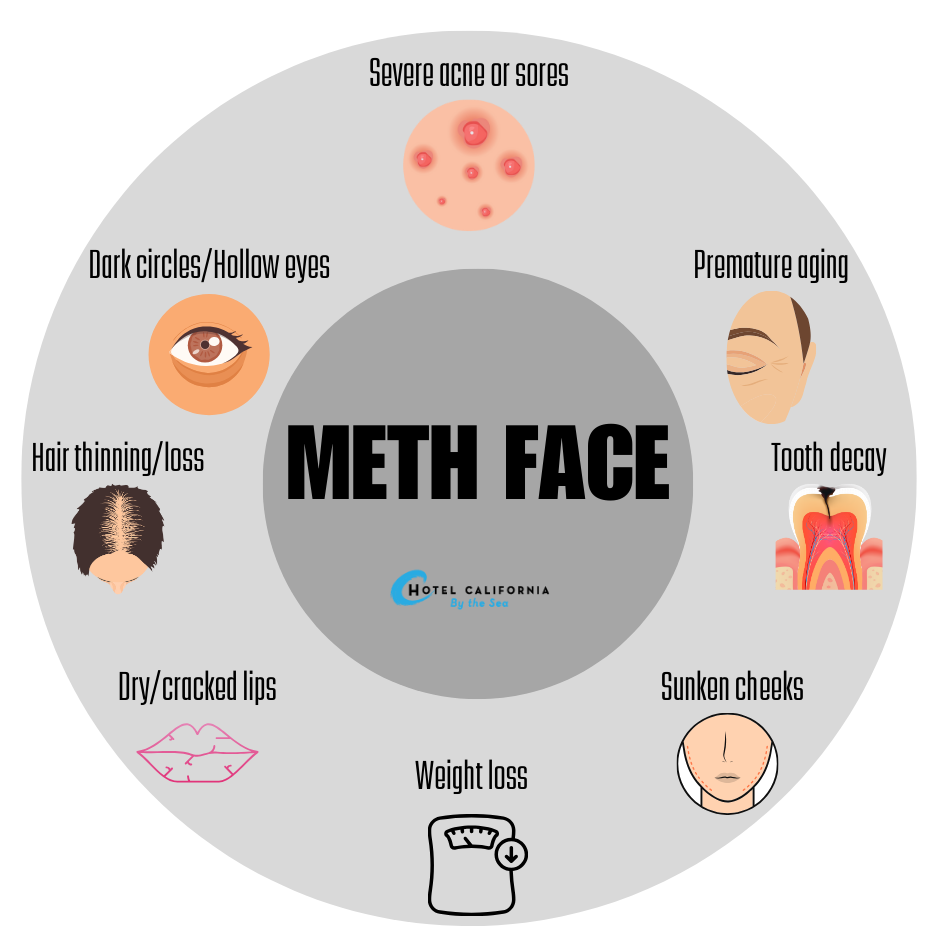What is Meth Face?
Methamphetamines are one of the most commonly abused drugs in the U.S. It is especially prevalent in the American Midwest. Meth abuse and addiction has become a growing problem. Research has found that an estimated 16 million people have tried meth at least once. One of the most common and most noticeable side effects of meth abuse is the visible deterioration of a person’s physical appearance, especially in the face. In serious cases, it can leave a person completely unrecognizable. This is where the term meth face comes from.

Meth face is a term used to describe the drastic physical effects that meth has left on a person who has been misusing and abusing the drug. Face sores can develop and often take weeks or months to heal. In most cases, they cannot heal due to constant scratching and picking of the skin. This often leaves evident scars, scabs and lesions across the face and can lead to physical signs of premature aging and other signs of overall declining health.
How does Meth work?
Meth is a powerful and addictive central nervous system stimulant substance. Crystal meth is a particularly potent form of the drug. The brain releases a natural neurochemical called dopamine. Dopamine is responsible for factors such as feelings of contentment, satisfaction and joy. It plays an important role in the flow of your brain chemistry. Low levels of dopamine can cause negative effects on a person’s mood, motivation and memory.
When a person begins using meth, the drug takes over the brain’s natural reward system. It forces the brain to release unnaturally high amounts of dopamine. When these high levels occur, it can produce intense feelings of euphoria, increased energy, and even feelings of invulnerability. This rush of dopamine can be very intense. It causes the user to want more of the feelings and therefore causes them to take more drugs and more frequently in order to achieve the same experience.

Signs you may have a Meth Addiction
- Hyperactivity
- Restlessness
- Lip and finger burns
- Spasitc movements
- Unpredictable sleeping patterns and insomnia
- Rotting teeth and other dental problems
- Mood swings
- Extreme and drastic weight loss
- Paranoia and hallucinations
- Outbursts
- Dilated pupils
- Skin sores
- Increased breathing, heart rate and blood pressure
- Mental health issues such as anxiety and confusion
- Violent behaviors
- Increased risk of contracting diseases such as HIV and Hep B.
Check Your Insurance Coverage for FREE
Find out if your insurance covers addiction treatment in minutes. We accept most insurance!
The physical attributes of Meth Face
- Meth Mouth – Meth use often leads to tooth decay-causing teeth to break, rot or fall out due to dry mouth and poor oral hygiene. Smoking meth also requires the user put a hot torch or flame pressed against the glass, which is then pressed against their mouth. The hot glass will often burn the lips and surrounding areas of the mouth. This can also cause cuts and sores to appear on the inside and outside areas of the mouth. The combination of these elements contributes to what is commonly referred to as meth mouth.
- Meth Mites – Meth mites occur when users begin to experience sensations of bugs or insects crawling inside or on top of their skin. Users will begin scratching and picking at the skin in an attempt to get rid of the presumed bugs. The sensation can become some intense and unbearable, that users will create lesions on the skin including on the face. Sometimes the lesions become open sores if they are not properly treated leading to face sores. An estimated 40% of patients who seek treatment for meth abuse have experienced meth mites.
- Wrinkles and signs of premature aging – Smoking any type of drug including meth, can cause the skin to turn into a leathery-like texture. This can lead to wrinkles, a rough textures and cause the look of premature aging. Physicians have reported that meth users often look about 10-15 years old than they actually are.
- Skin sagging – Skin sagging and loss of fat around the cheeks is often caused by drastic weight loss. Oftentimes, users of meth will forgo eating and nutrition and opt for doing meth and drugs instead. This can lead to drastic weight loss and a drastic decrease in volume in the face.
- Sunken eyes and hollow cheeks – Drastic weight loss and malnutrition also lead to sunken eyes and hollow cheeks. This gives the appearance of looking gaunt and skeleton-like.
- Pale and sallow skin – Lack of hygiene, poor nutrition and a weakened immune system can lead to the face looking pale and sallow.
- Sores, scabs and lesions – The constant picking of skin can lead to open sores and lesions, which then become infected leading to scabs and scars forming on the face. This also causes redness and discoloration all over the face.
Other factors that can contribute to Meth Face
Meth is a water-soluble drug. Sometimes during meth use, a person can sweat out some of the toxic substances through their pores. Sweat that contains meth toxins can damage the skin and even cause the development of sores to form on the skin’s surface.
Because meth is known to suppress the body’s immune system, this could lead to users developing other types of disease and being unable to naturally fight them off. It could lead to the development of herpes outbreaks and even dermatitis in areas around the face.
Meth use also leads to the constriction of blood flow to the skin. This makes it more difficult for the body to get blood to different systems including to the face. Without proper blood flow to the facial skin, it can make it more difficult to repair any damage to the skin on the face. This also naturally causes the user to lose its natural healthy glow and skin elasticity.
Reach out to Hotel California by the Sea
We specialize in treating addiction and other co-occurring disorders, such as PTSD. Our Admissions specialists are available to walk you through the best options for treating your addiction.
Treatment for Meth Use Disorder
Meth is a highly addictive substance. It can cause changes in brain structure and function. Meth influences the dopamine system. Meth can also lead to physical changes, which are especially prominent in the face. It is also known as meth face. There are some treatments for face sores such as antibiotics, topical anesthetics and topical steroids. However, depending on the severity of meth face, sometimes, these treatments may not be enough.
Hotel California by the Sea specializes in substance use disorder treatment. We provide treatment at all levels of care including detox, residential, PHP and IOP. We utilize effective treatment methods such as cognitive behavioral therapy, dialectical behavioral therapy, family therapy and group therapy. Hotel California by the Sea is dedicated to providing the tools, resources and support our clients need in order to overcome their addiction.
References:
https://www.addictioncenter.com/community/top-10-worst-meth-transformations
https://www.medicalnewstoday.com/articles/meth-face-sores
https://recovered.org/blog/can-damaged-skin-heal-after-meth-addiction
https://abc13.com/methamphetamine-meth-abuse-faces-of/1688177
https://www.rehabcenter.net/methamphetamine/skin/
